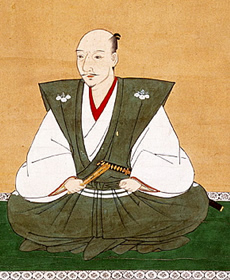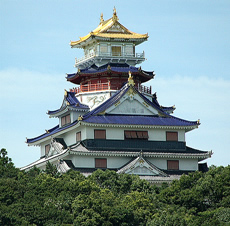World History
 Oda Nobunaga overthrew the Ashikaga Shogunate and took control of half of Japan, becoming the virtual dictator in the 1570s. He ended a number of civil wars that had been waged throughout Japan, but his early death ensured renewed fighting.
Oda Nobunaga overthrew the Ashikaga Shogunate and took control of half of Japan, becoming the virtual dictator in the 1570s. He ended a number of civil wars that had been waged throughout Japan, but his early death ensured renewed fighting.
Oda Nobunaga was born in 1534 in Owari Province in Honshu. His father was a government official who served under the Ashikaga Shogunate and became wealthy.
After his father’s death when he was 17, he grew the family landholdings and made himself lord of Nagoya Castle, which became his first headquarters, where he raised and trained a loyal band of military retainers. Oda began his conquests in 1555. Meeting with success, he decided to lead his men to reunify Japan.
Nobunaga’s first aim was to secure his flanks from attack, and he formed an alliance in 1562 with Matsudaira Motoyasu, who later became Tokugawa Ieyasu, that secured his heartland of Owari, a fertile region of Japan, with Nagoya as an important trading city. Next he moved his army toward Kyoto, the imperial and shogunal capital. Nobunaga used new military technology, including the arquebus and muskets, to great advantage.
In 1568, Nobunaga started to involve himself in Kyoto politics, first by supporting the new shogun Ashikaga Yoshiaki. He would later oust him in 1573, thus ending the Ashikaga Shogunate. To protect his position, Nobunaga then built the mighty Azuchi Castle on Lake Biwa.
With the reins of government in his hands, Nobunaga was determined to make important changes. One of his first acts was to remove road tolls, to help increase domestic trade and diminish the wealth and control of the local daimyo (nobles) who collected them.
Another of his targets was the powerful Buddhist Tendai sect, headquartered at Enryakuji. Nobunaga was successful and destroyed most of the Enraykuji monastery. Another Buddhist sect, the Ikko sect, however, proved to be more of a problem.
Nobunaga began to battle them from 1570. After bitterly fought campaigns, he finally prevailed in 1580, capturing their headquarters near Osaka and massacring the rest of the remaining defenders.
Nobunaga was a harsh and vengeful ruler who forced many of his opponents to commit suicide. But he was generous to his supporters and rewarded them with confiscated farms and land previously owned by the temples. Nobunaga was friendly toward Christian missionaries and allowed Jesuits to build a church in Kyoto. His motives included the belief that Christianity would erode the influence of the Buddhist sects.
By 1582, Nobunaga had defeated many of his opponents, had unified much of the country, and had nearly half the provinces of Japan under his rule. On June 21, 1582, Nobunaga was ambushed while at Honnoji, a temple of the Nichiren sect located near Kyoto, by Akechi Mitsuhide, an aggrieved vassal.
Oda Nobunaga began the work of establishing a unified government in Japan after power had slipped away from the declining Ashikaga Shogunate. His career was cut short, but his goals were continued by his greatest general, Toyotomi Hideyoshi.
- Ashikaga Shogunate
Ashikaga Shogunate This shogunate saw the Ashikaga family dominate Japanese society, ruling for much of the period from their headquarters in the Muromachi district of Kyoto. As a result the shogunate, or bakufu (“tent government,” in effect a military...
- Japanese Feudalism
Japanese Feudalism When most people think of feudalism, medieval Europe from about the ninth to 15th centuries is most likely to come to mind. The term feudalism is of fairly recent origin, coined in the 17th century by lawyers and antiquarians who used...
- Onin War In Japan
Onin War in Japan The Onin War came about directly as a result of the declining power of the Ashikaga Shogunate. The Ashikaga Shogunate, or military government, had been founded in 1336–37, by the astute Ashikaga Takauji. Takauji had been sent...
- Christian Century In Japan
Christian Century in Japan Francis Xavier, a founder of the Society of Jesus, arrived in Japan in 1549, inaugurating a century of Catholic Christian missionary activity in that country. After enjoying enormous success, Christians suffered brutal persecution...
- Sengoku Jidai
Sengoku Jidai The 100 years from the end of the 15th to the end of the 16th century is known in Japan as the Sengoku Jidai, the Warring States Era (or Era of the Country at War), named after a period in China during the third century c.e. The Ashikaga...
World History
Oda Nobunaga - Japanese General

Oda Nobunaga was born in 1534 in Owari Province in Honshu. His father was a government official who served under the Ashikaga Shogunate and became wealthy.
After his father’s death when he was 17, he grew the family landholdings and made himself lord of Nagoya Castle, which became his first headquarters, where he raised and trained a loyal band of military retainers. Oda began his conquests in 1555. Meeting with success, he decided to lead his men to reunify Japan.
Nobunaga’s first aim was to secure his flanks from attack, and he formed an alliance in 1562 with Matsudaira Motoyasu, who later became Tokugawa Ieyasu, that secured his heartland of Owari, a fertile region of Japan, with Nagoya as an important trading city. Next he moved his army toward Kyoto, the imperial and shogunal capital. Nobunaga used new military technology, including the arquebus and muskets, to great advantage.
  |   |
In 1568, Nobunaga started to involve himself in Kyoto politics, first by supporting the new shogun Ashikaga Yoshiaki. He would later oust him in 1573, thus ending the Ashikaga Shogunate. To protect his position, Nobunaga then built the mighty Azuchi Castle on Lake Biwa.
With the reins of government in his hands, Nobunaga was determined to make important changes. One of his first acts was to remove road tolls, to help increase domestic trade and diminish the wealth and control of the local daimyo (nobles) who collected them.
 |
| Azuchi Castle |
Nobunaga began to battle them from 1570. After bitterly fought campaigns, he finally prevailed in 1580, capturing their headquarters near Osaka and massacring the rest of the remaining defenders.
Nobunaga was a harsh and vengeful ruler who forced many of his opponents to commit suicide. But he was generous to his supporters and rewarded them with confiscated farms and land previously owned by the temples. Nobunaga was friendly toward Christian missionaries and allowed Jesuits to build a church in Kyoto. His motives included the belief that Christianity would erode the influence of the Buddhist sects.
By 1582, Nobunaga had defeated many of his opponents, had unified much of the country, and had nearly half the provinces of Japan under his rule. On June 21, 1582, Nobunaga was ambushed while at Honnoji, a temple of the Nichiren sect located near Kyoto, by Akechi Mitsuhide, an aggrieved vassal.
Oda Nobunaga began the work of establishing a unified government in Japan after power had slipped away from the declining Ashikaga Shogunate. His career was cut short, but his goals were continued by his greatest general, Toyotomi Hideyoshi.
- Ashikaga Shogunate
Ashikaga Shogunate This shogunate saw the Ashikaga family dominate Japanese society, ruling for much of the period from their headquarters in the Muromachi district of Kyoto. As a result the shogunate, or bakufu (“tent government,” in effect a military...
- Japanese Feudalism
Japanese Feudalism When most people think of feudalism, medieval Europe from about the ninth to 15th centuries is most likely to come to mind. The term feudalism is of fairly recent origin, coined in the 17th century by lawyers and antiquarians who used...
- Onin War In Japan
Onin War in Japan The Onin War came about directly as a result of the declining power of the Ashikaga Shogunate. The Ashikaga Shogunate, or military government, had been founded in 1336–37, by the astute Ashikaga Takauji. Takauji had been sent...
- Christian Century In Japan
Christian Century in Japan Francis Xavier, a founder of the Society of Jesus, arrived in Japan in 1549, inaugurating a century of Catholic Christian missionary activity in that country. After enjoying enormous success, Christians suffered brutal persecution...
- Sengoku Jidai
Sengoku Jidai The 100 years from the end of the 15th to the end of the 16th century is known in Japan as the Sengoku Jidai, the Warring States Era (or Era of the Country at War), named after a period in China during the third century c.e. The Ashikaga...
